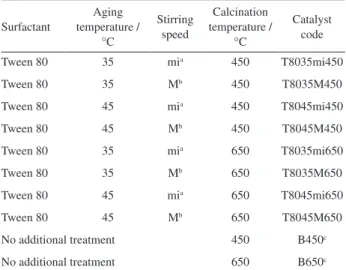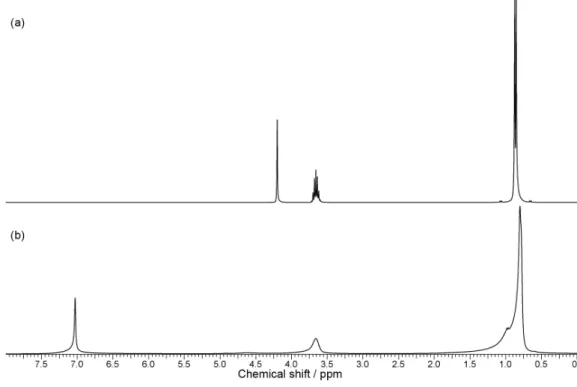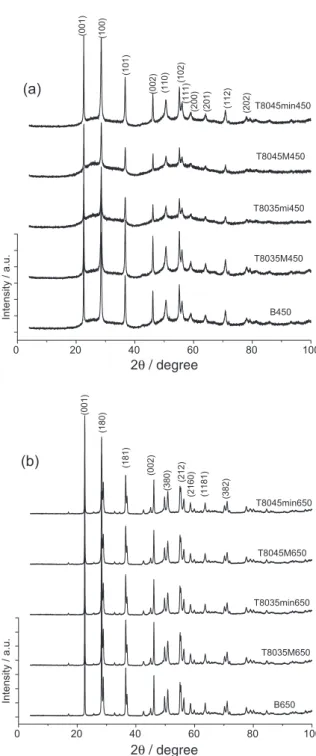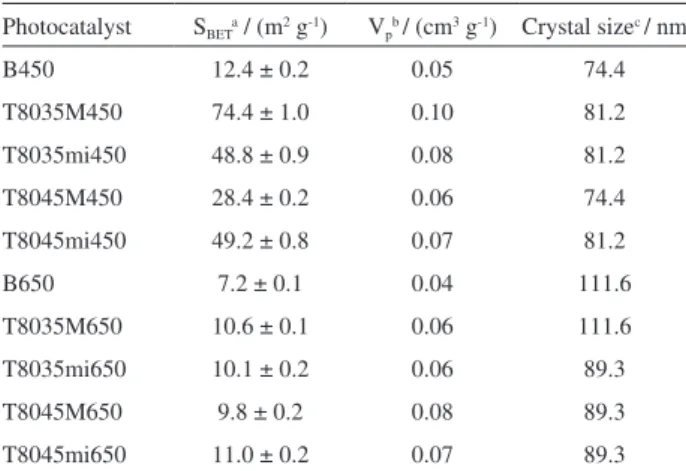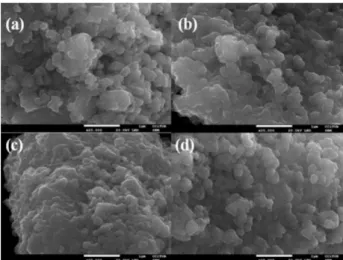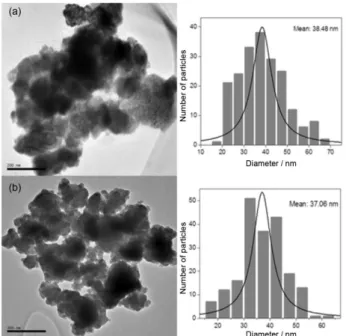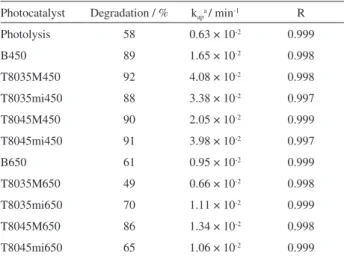Article
J. Braz. Chem. Soc., Vol. 27, No. 2, 303-313, 2016. Printed in Brazil - ©2016 Sociedade Brasileira de Química 0103 - 5053 $6.00+0.00
A
*e-mail: machulekjr@gmail.com
Synthesis and Characterization of Mesoporous Nb
2O
5and Its Application for
Photocatalytic Degradation of the Herbicide Methylviologen
Douclasse C. Castro, Rodrigo P. Cavalcante, Juliana Jorge, Marco A. U. Martines, Lincoln C. S. Oliveira, Gleison A. Casagrande and Amilcar Machulek Jr.*
Instituto de Química, Universidade Federal de Mato Grosso do Sul, Av. Senador Filinto Müller, 1555, CP 549, 79074-460 Campo Grande-MS, Brazil
This article reports the characterization of mesoporous Nb2O5 synthesized by the sol-gel method for application in photocatalysis. The emerging contaminant methylviologen was employed for photocatalytic tests. Parameters inherent to the synthesis process, such as stirring rate, aging temperature, and calcination temperature, were employed for a range of values to improve the synthetic route. The powders obtained were characterized by thermogravimetric analysis, X-ray diffraction, scanning and transmission electron microscopy, speciic surface area, infrared spectroscopy, energy-dispersive spectroscopy, and diffuse relectance spectroscopy. In samples calcined at 450 °C, a mixture of amorphous and hexagonal phases was observed, with a predominance of the former, while in samples calcined at 650 °C the orthorhombic phase predominated. Samples calcined at 450 °C exhibited larger speciic surface areas. Mesoporous structures were conirmed for samples T8035M450 and T8045mi450, which displayed higher photoactivity, with roughly 90% removal of methylviologen.
Keywords: advanced oxidation processes, photocatalysis, sol-gel method, mesoporous Nb2O5,
methylviologen
Introduction
The expansion of intensive farming around the world and the large-scale development of the agrochemical industry in response to the growing demand for food, have led to a drastic increase in the amount and variety of pesticides in surface water and groundwater.1,2 Pesticides
are responsible for most of the efluents containing high concentrations of toxic non-biodegradable compounds not amenable to removal by conventional water treatment.3,4
Pesticide management has been an issue of major concern in scientiic circles, given the potential environmental impact of these compounds.2
In Brazil, the demand for pesticides has been increasing year by year, and the country is currently one of the largest consumers of these products. According to the Brazilian Union of Plant Defensive Industries (SINDIVEC),5 the
domestic agrochemical market grew by 6-9% in 2014. Of the pesticides employed in crop production, herbicides have become the most used. Reasons for this increase include the expansion of planted areas and the diffusion of agricultural
technologies. In Brazil, herbicides represented 19% of pesticide sales in 2013, accounting for US$ 3.739 billion.5
Among numerous emerging contaminants, paraquat, also known as methylviologen (MV2+), a non-selective
contact herbicide of the bipyridyl class (dimethyl-4,4'-bipyridinium dichloride), was irst marketed in 1962. Its low cost and high effectiveness have placed it among the most widely employed herbicides in crops such as rice, coffee, sugarcane, beans and soybeans in over 130 countries.6-8
Toxicity and persistence make pesticides a serious environmental concern,1 it is necessary to introduce
additional technologies to suitably remove these compounds from efluents. Advanced technologies have recently been used in the treatment of efluents containing multiple compounds, and advanced oxidation processes (AOPs) have gained particular attention for their ability to successfully remove persistent organic compounds.9-14
By means of physical and chemical mechanisms that produce powerful transitional species, particularly hydroxyl radicals (HO•), of high oxidative power, AOPs
biodegradable, less toxic compounds and/or fully mineralizing them into carbon dioxide, water and inorganic anions.15,16 Among AOPs, heterogeneous photocatalysis has
been a focus of interest for its ability to degrade harmful pollutants.17 The principle underlying heterogeneous
processes is the activation of a semiconductor by sunlight or artiicial light.18
When the surface of the semiconductor material is excited with photons with energy equal or higher than band gap energy (Egap), electrons are promoted from the valence
band (VB) to the conduction band (CB). As a result of this, an electron (e–
CB) hole (h+VB) pair is produced (equation 1).19
CB VB
semiconductor hv e− h+
+ → + (1)
The positive holes oxidize either pollutant directly (equation 2, pollutant is represented by P) or react with adsorbed species such as water molecules or hydroxide ion to produce HO• radicals (equation 3).20 Similarly the
electron can be donated to an electron acceptor (oxygen adsorbed) to produce superoxide radical anion, O2•−
(equation 4).21
VB
h+ P P+
+ → (2)
VB 2 ads
h+ H O HO H+
+ → + (3)
CB 2ads 2
e− O O−
+ → (4)
Essentially, these reactive transitory species generated (HO•,O
2•−,hVB+, HO2•) are the main responsible for the
degradation of organic pollutants present in the medium. However, a series of secondary reactions (equations 5-8) can occur.22,23
2 2 ads 2 2
O− H O H O
+ →
(5)
2 2
H O →2HO (6)
VB 2 2
h+ HOO− H O
+ → (7)
CB 2
e− HOO− HO−
+ → (8)
Heterogeneous photocatalysis typically employs transition metal oxides and sulides (e.g., TiO2, Fe2O3, WO3,
SnO2, ZnO, Nb2O5, CdS or ZnS) that act as photosensitizers
in photoinduced processes, owing to electronic structures in which the valence band is semi-illed, while the conduction band remains empty.24
Despite the effectiveness of TiO2, ZnO, and Nb2O5 as
catalysts,25 TiO
226-30 and ZnO31-34 are the most employed,
owing to their ability to form stable hydrocolloids in aqueous media, facilitating interaction with the compound to be degraded and improving photoactivity.35 However,
because recovery of these semiconductors for reuse is complex and laborious,36 alternative semiconductors
have been viewed as a promising solution to meet the requirements of Green Chemistry Principle No. 7 (use of renewable sources of raw materials).37
Despite a band gap energy of 3.4 eV, higher than that of TiO2 (3.2 eV), Nb2O5 has the advantage of not
forming a stable hydrocolloid with target compounds. It can thus be easily recovered and reused, without signiicant loss of photocatalytic activity, which makes it a promising catalyst for use in photocatalysis.38,39 Because
of its acidic nature, Nb2O5 is widely used in catalytic
reactions such as dehydration, esteriication, hydrolysis, condensation, and particularly oxidation reactions. Nonetheless, its photocatalytic properties remain scarcely investigated.38,40-45
Roughly 98% of known reserves of niobium are located in Brazil. The country currently accounts for over 90% of all niobium traded worldwide, followed by Canada and Australia.46 Investigating new technological applications
for this metal is therefore highly relevant.
Most industrial processes using Nb2O5 as a photocatalyst
employ the micrometric form of this material, obtained by calcining the commercial oxide or by treatment with reagents such as hydrogen peroxide, acids, and alkalis,43
a disadvantage in heterogeneous photocatalysis, since catalyst photoactivity depends directly on physical and chemical properties that include surface area, morphology, mesoporous structure, adsorption capacity, crystal structure, and particle size.47 The ability to synthesize the
catalyst to achieve control of properties such as formation of mesoporous structures is therefore of great interest.
The principal approaches for synthesizing nanostructures are the sol-gel, polymer precursor, hydrothermal, and solvothermal methods.48 The sol-gel method has long been
used to produce porous materials exhibiting large surface areas.39 Molecular precursors, especially metal alkoxides,
are commonly employed, owing to their high purity and ease of control of the synthesis process.49,50 Conversion of
an alkoxide into a gel occurs by precipitation followed by hydrolysis and condensation (with polymerization of the hydrolyzed species).51
The purpose of this study was to characterize mesoporous Nb2O5 photocatalysts synthesized by the
sol-gel method, considering their use in photocatalysis and employing MV2+ as a model emerging contaminant.
(XRD), scanning and transmission electron microscopy (SEM and TEM), speciic surface area (BET), Fourier-transform infrared spectroscopy (FTIR), energy dispersive spectroscopy (EDS), and diffuse relectance spectroscopy (DRS).
Experimental
Reagents
All reagents were of analytical grade. MV2+ (98%) was
purchased from Sigma Aldrich, isopropyl alcohol (99.8%) from Merck, surfactant Tween 80 (polyoxyethylene (20) sorbitan monooleate, C64H124O26) from Synth, and
niobium(V) chloride from Companhia Brasileira de Metalurgia e Mineração (CBMM).
Synthesis of mesoporous Nb2O5
Nb2O5 nanoparticles were synthesized by the sol-gel
method from the niobium(V) isopropoxide, as adapted from the procedure described by Antonelli et al.52 Synthesis was
performed by hydrolysis, followed by condensation of the alkoxide and aging under constant stirring and controlled temperature. The route employed has the advantage of eliminating the need for chelating agents.
As a irst step, niobium isopropoxide (C15H35NbO5)
was synthesized. In a glovebox with nitrogen atmosphere, 1.89 g of niobium(V) chloride (NbCl5) was dissolved in
10 g of isopropyl alcohol (equation 9). The reaction system was kept under constant stirring for 40 min until all NbCl5
dissolved. To evaluate the formation of C15H35NbO5, the
product obtained was characterized by hydrogen nuclear magnetic resonance (NMR).
NbCl5 + 5 (CH3)2CHOH → Nb((OCH)(CH3)2)5 + 5 HCl↑ (9)
The synthesized niobium isopropoxide was mixed with 0.3 g of Tween 80 surfactant under stirring and 1.8 mL of ultrapure water was then added. The resultant mixture was left to age for 72 h. The precipitate was separated by centrifugation (4500 rpm for 30 min), washed with ultrapure water, dried, and calcined at ambient temperature. Two oxides, synthesized in the absence of surfactant, served as blanks.
Synthesis conditions (aging temperature, stirring speed, calcination temperature) have a pronounced effect on the physicochemical properties of products (e.g., phase, morphology, particle size, specific surface area) and consequently on their photocatalytic properties, and were therefore investigated (Table 1).
Characterization
The surface morphology and surface topography of samples were examined using a JSM-7100F scanning electron microscope and a JEM-2100 transmission electron microscope (both from Jeol). For SEM, the samples were mounted on carbon tape and sputter-coated with platinum. For TEM, the samples were dispersed in ethanol with the aid of ultrasound and deposited onto copper grids. Mean diameter of particles was determined by counting the particles shown in TEM images from different ields in each sample, using ImageJ software.53
For qualitative analysis of the elemental composition of the synthesized material, EDS measurements were performed using a JSM-6830LV scanning electron microscope (Jeol) with a 30 kV electron beam.
For thermogravimetry, the samples were placed in a platinum crucible and analyzed on a TGA Q50 device (TA Instrument) (heating rate: 10 °C min-1; temperature
range: 25-900 °C; nitrogen atmosphere, with low rates of 40 mL min-1 in the thermobalance and 60 mL min-1 in the
furnace). The crystal structures of powders were investigated by analyzing XRD from 4 to 100° (2θ) at 0.017° intervals and measuring time of 50 s step-1, employing an X’pert PRO
MRD diffractometer (PANalytical) as the Cu Kα radiation source (λ = 1.5406 Å). Speciic surface area, pore volumes, and pore size distributions were determined by nitrogen adsorption analysis, based on BET isotherms. The samples were degassed at 150 °C for 15 h and measurements were taken at 77 K. UV-Vis diffuse relectance electronic spectra of the powders were obtained using a pulsed PX2 xenon lamp and a USB-4000 detector (both from Ocean Optics), optical
Table 1. Variables investigated in the synthesis of mesoporous Nb2O5 by
the sol-gel method
Surfactant
Aging temperature /
°C
Stirring speed
Calcination temperature /
°C
Catalyst code
Tween 80 35 mia 450 T8035mi450
Tween 80 35 Mb 450 T8035M450
Tween 80 45 mia 450 T8045mi450
Tween 80 45 Mb 450 T8045M450
Tween 80 35 mia 650 T8035mi650
Tween 80 35 Mb 650 T8035M650
Tween 80 45 mia 650 T8045mi650
Tween 80 45 Mb 650 T8045M650
No additional treatment 450 B450c
No additional treatment 650 B650c
ibers, and Ocean Optics SpectraSuite software. Magnesium oxide was used as the reference for total relection. Scans were performed at 250-800 nm. FTIR spectra were recorded using an MB spectrophotometer (Bomem), with scanning at 500-4000 cm-1, employing powder dispersion in potassium
bromide pellets.
Photodegradation procedures
Photocatalytic efficiency was evaluated by MV2+
photodegradation rates. The experiments were conducted in an annular glass photochemical reactor with 1 L capacity and quartz casing for insertion of the radiation source. UV radiation was provided by a 125 W medium-pressure mercury vapor lamp (Philips) of 4.59 × 1021 s-1 photon lux
experimentally determined by chemical actinometry.12,27
The lamp, without its protective casing, was positioned lengthways to the reactor, within a quartz tube. A magnetic stirrer homogenized the solution throughout the experiment. The photochemical reactor temperature was monitored throughout the reaction at 25 °C with the aid of a thermostatic bath. For the photodegradation experiments, 0.5 g of the desired catalyst was placed in 500 mL of MV2+
solution at 0.2 mmol L-1. The experiments were performed
without pH control (pH ca. 6.0 ± 0.2). Reaction time was 100 min and aliquots of approximately 4 mL were collected at predetermined intervals and iltered. Degradation was monitored by absorption spectrophotometry in the UV-Vis range on a U-3000 UV-Vis spectrophotometer (Hitachi).
Results and Discussion
Characterization results
1H NMR analysis was performed to confirm the
presence of niobium isopropoxide (a precursor of Nb2O5
synthesis), formed by reacting NbCl5 with isopropanol. The
isopropanol spectrum (Figure 1a) shows three characteristic regions around 0.9, 3.7, and 4.2 ppm, corresponding to a carbon doublet, a sextet, and hydroxyl, respectively. In the spectrum shown in Figure 1b, the band corresponding to the hydroxyl group, at 4.2 ppm, disappears, owing to replacement of a hydrogen with a niobium atom (see equation 9), conirming the formation of niobium isopropoxide. The presence of niobium (a paramagnetic atom) causes the neighboring hydrogen atoms to relax, which translates to the spectral changes observed at 3.7 and 4.2 ppm.
The thermal behavior of the synthesized oxides was investigated by monitoring the removal, during TGA/ DTG analysis, of adsorbed water and the organic matter originating from isopropanol and surfactant. This technique was also employed as a pre-step for selecting the calcination temperature range to be employed in the synthetic route.
All materials synthesized exhibited similar behaviors. Figure 2 shows the proile of mass loss as a function of temperature and its derivative for the synthesized oxide, for an aging temperature of 45 °C and minimum stirring speed. Three major stages can be observed. The irst spans the
Figure 1. 1H NMR spectrum (300 MHz, CDCl
50-100 °C region, with a 9.41% mass loss corresponding to removal of surface water, as well as isopropyl alcohol, since organic residues are often present in samples synthesized by the sol-gel method.54 The second, in the 100-300 °C
range accounted for a mass loss of 7.99%, attributed to decomposition of organic matter, surfactant, and niobium isopropoxide and one last step in the region of 300-560 °C attributed to removal of organics adsorbed on the surface and to structural arrangement of the oxide. On the DTG curve, the irst step is supported by two exothermic peaks at about 50 and 100 °C, while the second step is supported by four peaks, at about 230, 479, and 554 °C, showing that thermodecomposition involves more steps than indicated by the TGA curve. Throughout the analysis, mass loss was about 19% of the initial mass, with 81% of the residue consisting of Nb2O5.
XRD was employed to examine the changes occurring in the crystal structures of the oxides (Figure 3). As expected, the oxides synthesized via the controlled route in the presence of surfactant exhibited lower crystallinity than samples B450 or B650 (as revealed by the high intensity of the majority of dominant diffraction peaks of these samples), possibly because the controlled parameters imparted relatively well-organized atomic arrangements to the synthesized materials, hence their low crystallinity.
The diffractograms of samples calcined at 450 °C (Figure 3a) revealed a mixture of hexagonal and predominantly amorphous phases, the latter conirming the presence of mesoporous particles. All wide-angle peaks in both patterns correspond to a pure TT-phase (JCPDS, 28-317), with major peaks indexed as (001), (100), (101), (002), (110), (102), (111), (200), (201), (112), and (202), respectively. These results reveal similarities with TT-phase samples, according to parameters published by Schaffer et al.55 Other investigators also obtained an
amorphous phase by calcining at 400-500 °C.56-59
For a higher calcination temperature (650 °C, Figure 3b), peaks attributed to the orthorhombic phase55
were observed, with major peaks indexed as (001), (180), (181), (002), (380), (212), (202), (2160), (1181), and (382), respectively.56,59-63
Nb2O5 crystal size (Table 2) was estimated from
the position and height of peak (001) using the Debye-Scherrer equation-namely, D = 0.89 λ/(β cosθ). Crystal size increased with rising calcination temperatures, ranging from 74.44 to 111.65 nm.
0 100 200 300 400 500 600 700 800 900 85 90 95 100 DTG TGA
Temperature /oC
W e ig h t / % 0.00 0.03 0.06 0.09 0.12 0.15 (dn/dt )/ (% mi n -1 )
Figure 2. TGA/DTG curves for the sample synthesized at an aging
temperature of 45 °C, with minimum stirring.
0 20 40 60 80 100
(a) (1 1 2 ) (2 0 1 ) (2 0 0 ) (1 1 1 ) (1 0 2 ) (1 1 0 ) (0 0 2 ) (1 0 1 ) (1 0 0 ) (0 0 1 ) (2 0 2 ) T8045min450 T8045M450 T8035mi450 T8035M450 B450
2θ/ degree
2θ/ degree
0 20 40 60 80 100
(b) (1 1 8 1 ) (3 8 2 ) (2 1 2 ) (3 8 0 ) (2 1 6 0 ) (1 8 1 ) (1 8 0 ) (0 0 1 ) (0 0 2 ) T8045min650 T8045M650 T8035min650 T8035M650 B650
Intensity / a.u.
Intensity / a.u.
Figure 3. Diffractograms of photocatalysts calcined at (a) 450 °C;
Table 2 shows the BET surface areas (SBET) and pore
volumes (Vp) of the synthesized oxides. Calcination
temperature affects area-to-mass values, as shown by the lower surface area values obtained for the catalysts calcined at 650 °C. Semiconductors with larger surface areas tend to provide better photocatalytic responses.64 A reduction
in surface areas with increasing temperatures has also been observed elsewhere.58,65-67 Maurer and Ko67 found
that a decrease in surface area with increasing calcination temperature corresponded to changes in the crystal phase of Nb2O5-results consistent with our XRD data. In oxides
synthesized under maximum stirring speed and calcined at 450 °C, increasing aging temperatures caused SBET and Vp
values do diminish. Also, all the oxides calcined at 450 °C exhibited higher SBET and Vp values than oxide B450.
Pores with diameters of 2 to 50 nm are known to correspond to mesoporous materials.68 For oxides
T8035M450 and T8045mi450, pore diameters of 6.60 and 4.10 nm were obtained, respectively, and their nitrogen adsorption-desorption isotherms were consistent with typical patterns for mesoporous materials (Type IV, in the IUPAC classiication of adsorption isotherms), indicating the mesoporous nature of these materials.69 For the other
synthesized oxides, no isotherms typical of mesoporous materials were observed. Figure 4 compares typical isotherms of a mesoporous (T8035M450) and a non-mesoporous sample (T8035M650), conirming the closure of pores with increasing temperatures.
Band gap energy (Egap) values were estimated by
linear regression of the absorption slope by extrapolating the tangent to the energy (E = 1240.82/λ) vs. absorbance
curve obtained from DRS experiments. Figure 5 shows the behavior of absorbance, from which the Egap value was
determined for T8035M450 sample. Egap values of the other
photocatalysts were determined in the same manner. For all the synthetic routes, the estimated Egap values remained
within the 3.0-3.1 eV range-consistent with published values of 3.08-3.20 eV,56 3.22 eV,60 and 2.99-3.17 eV.70 The
synthesized oxides can therefore be employed as UV-Vis radiation-absorbing materials.
All the oxides were subjected to infrared spectroscopy to monitor the removal of adsorbed water and organic matter (such as surfactant) that takes place during calcination, as well as the formation of oxide polymer networks. All spectra exhibited similar peaks. Figure 6 shows the curves corresponding to the infrared spectra obtained before and after heat treatment at 450 °C of the sample synthesized under maximum stirring and aging temperature of 35 °C.
In the FTIR spectra, Nb2O5 formation is corroborated
by the presence of a strong, broad band around 620 cm-1,
Table 2. Characterization of the photocatalysts investigated
Photocatalyst SBETa / (m2 g-1) Vpb / (cm3 g-1) Crystal sizec / nm
B450 12.4 ± 0.2 0.05 74.4
T8035M450 74.4 ± 1.0 0.10 81.2
T8035mi450 48.8 ± 0.9 0.08 81.2
T8045M450 28.4 ± 0.2 0.06 74.4
T8045mi450 49.2 ± 0.8 0.07 81.2
B650 7.2 ± 0.1 0.04 111.6
T8035M650 10.6 ± 0.1 0.06 111.6
T8035mi650 10.1 ± 0.2 0.06 89.3
T8045M650 9.8 ± 0.2 0.08 89.3
T8045mi650 11.0 ± 0.2 0.07 89.3
aBET surface areas (S
BET), measured by the BET method; bpore volumes
(Vp) obtained from the volume of N2 adsorbed at P/P0 = 0.98; cmeasured
from XRD data using the Debye-Scherrer equation.
0.0 0.2 0.4 0.6 0.8 1.0
0 10 20 30 40 50 60 70
80 Adsorption Desorption
(b) (a)
Volume
adsorbed
/
(cm
3 g -1 )
Relative pressure / (P/P0)
Figure 4. N2 adsorption-desorption isotherms for samples (a) T8035M450;
(b) T8035M650.
2.5 3.0 3.5 4.0 4.5
0.0 0.3 0.6 0.9 1.2
(b)
(a)
A
b
s
o
rb
a
n
c
e
/
a
.u
.
Energy / eV
Figure 5. (a) Absorbance; (b) linear regression, as a function of energy
attributed to symmetric stretching of Nb−Nb−O bonds,71,72
and bands around 810 and 867 cm-1, corresponding to
asymmetric stretching of [−O−Nb−O]n bonds.73
Surfactant and water removal can be confirmed by the absence of bands in the calcined sample-namely, (i) 3376 cm-1, corresponding to OH stretching resulting from
polymer association, (ii) 3660 and 1620 cm-1, corresponding
to stretching and angular deformation, respectively, of water molecules adsorbed onto the material, and (iii) 1296 cm-1
(C=O), 2918 cm-1 (ν C−H), and 1450 cm-1 (δ CH out of
plane), for C−H and ester bonds of the surfactant.74
Sample constituents were conirmed by EDS. FTIR conirmed the presence of niobium and oxygen in all synthesized oxides, demonstrating formation of Nb2O5.
With the aid of SEM data, the effect of variations in the synthetic routes on particle morphology in the oxides was evaluated. Figure 7 shows SEM images of samples B450 and B650, revealing that oxides consisted of particle clusters with a rounded morphology. Figure 7a, for sample B450, reveals that TiO2 particles are constituted of clusters.
Clusters of these types are smaller, more aggregated, and more defined than in oxide B650 (Figure 7b), indicating the inluence of the calcination temperature on particle morphology. These results are consistent with surface areas, since the clusters are closer together in the oxides synthesized at 650 °C, resulting in smaller surface areas.
Particles exhibited better-deined shapes in the oxides calcined at 650 °C (Figures 8 and 9), demonstrating the effect that surfactant presence during synthesis has on particle morphology, as well as the inluence of modifying the parameters investigated.
It is observed that oxides synthesized employing an aging temperature of 45 °C exhibited more pronounced clustering, but increased stirring speed produced more dispersed particles, albeit not uniformly organized. This lack of uniformity is typical of the surfactant used as a template, i.e., the micelles formed in its presence are not uniformly organized.
Figure 10 shows representative TEM images and histograms of particle size distributions (estimated using Feret diameters) for mesoporous sample T8035M450 and non-mesoporous sample T8045M450. Because Nb2O5
particles are polydisperse, their dimensions could not be
4000 3500 3000 2500 2000 1500 1000 500
0 20 40 60 80
δC-H
T
ra
n
s
m
it
ta
n
c
e
/
%
Wavenumber / cm-1
Non-calcined Nb2O5 Calcined Nb2O5
ν
sNb-O-Nb
ν
as[-O-Nb-O-]n
νH2O
δOH
CO2
νC=O
νC-H
Figure 6. FTIR spectrum (KBr) of Nb2O5 before and after heat treatment.
Figure 7. SEM images of samples (a) B450; (b) B650.
Figure 8. SEM images of samples (a) T8035mi450; (b) T8035M450;
(c) T8045mi450; (d) T8045M450.
Figure 9. SEM images of samples (a) T8035mi650; (b) T8035M650;
correctly determined, but most ranged from 30 to 50 mm in both samples. Also, sample T8035M450 was found to have a mesoporous structure, as shown by the N2
adsorption-desorption isotherms and TEM images.
Investigation of photocatalytic efficiency, based on methylviologen photodegradation
The photocatalytic activities of the obtained Nb2O5
nanoparticles were investigated in MV2+ degradation
(0.2 mmol L-1 of MV2+ and 1.0 g L-1 of catalyst). The
results of photodegradation experiments are shown in Figure 11a.
This study was employed to evaluate changes in physicochemical properties resulting from changes
in synthesis parameters (presence of surfactant, aging temperature, stirring speed, calcining temperature).
Direct photolysis was insuficient to degrade MV2+,
with only 58% of MV2+ was degraded after 100 min under
UV radiation with medium-pressure mercury vapor lamp (Philips, photon lux = 4.59 × 1021 s-1). Even the MV2+ has
a very strong UV signal at 257 nm that corresponds to a
π-π* transition of the electrons in the pyridinium ring75
and consequently, overlaying the spectrum of the incoming radiation (maximum intensity at 254 nm), its removal was ineficient. On the other hand, more than 90% of MV2+
was degraded within 60 min using oxides T8035M450 and T8045mi450.
To quantify differences between degradation rates, MV2+ oxidation rate data were employed to calculate k
ap,
the pseudo-irst-order kinetic constant (Table 3) from the regression line slopes representing −ln(MV2+/MV2+
o) vs.
time (Figure 11b).
As can be seen (Figure 11a and Table 3), the highest degradation rates (between 92 to 88%) were obtained with oxides calcined at 450 °C, in agreement with Paulis et al.,58
who found a strong relationship between calcining temperature and catalytic activity of Nb2O5. These results
were corroborated by the results of characterization, in which the oxides exhibited higher surface areas and mesoporous structures, both of which account for superior photocatalytic activity.
Another explanation for the improved photocatalytic response of oxides calcined at 450 °C is that the surfaces of oxides calcined at this temperature contain Brønsted-Lowry acid centers, and increasing the calcination temperature converts these active centers into Lewis acids.58 Because Lewis acids are electron-deicient76 and
MV2+ in aqueous solution is positively charged, these
conditions may have interfered with the interaction
Figure 10. TEM images and particle distribution of samples
(a) T8035M450; (b) T8045M450.
Figure 11. Methylviologen degradation curves; [MV2+]
between substrate and catalyst surface, lowering catalytic eficiency.
Results of MV2+ degradation using oxides calcined
at 450 °C showed that the aging temperature and stirring speed did not inluence in the photocatalytic eficiency of catalysts.
Degradation rates decreased signiicantly for the oxides calcined at 650 °C (see Table 3), probably owing to the higher crystallinity of these materials (as shown by XRD data). Crystallinity considerably decreases the rate of substrate adsorption onto the catalyst surface, consequently reducing photocatalytic response. Unexpectedly, the sample T8045M650 exhibited highest MV2+ degradation after
100 min of treatment. One possible explanation could be the fact that the oxide showed lower crystallinity, but to conirm a further study of XRD data would be necessary.
The application of Nb2O5 catalyst for the
photodegradation of contaminants is few reported in the literature in comparation of TiO2.
Padro et al.41 synthesized cellulose acetate/Nb
2O5 catalyst
in different proportions of Nb2O5 (3.9, 5.8, 6.7 and 10.9 in
wt.%) and applied as photocatalyst to degrade indigo carmine dye. The materials showed high quality to degrade indigo carmine dye in aqueous solution, obtaining nearly 100% degradation with the catalyst prepared with 6.7% of Nb2O5
in 30 min of reaction. In another study, Prado et al.38 applied
commercially available Nb2O5 catalyst to degrade indigo
carmine dye. The authors investigated the effect of catalyst concentration, pH and ionic strength (µ) and compared with degradation catalyzed by TiO2 and ZnO. Almost 100% of
dye degradation occurred at 90 min. Silva et al.77 prepared Nb
2O5 and Ag/Nb2O5 with 2 wt.%
silver by the impregnation method. For the catalytic
tests, the authors prepared solutions of 10 ppm of the following dyes: yellow neutracyl, dark blue neutracyl, blue dispersatyl, orange dispersatyl, black dispersatyl, black neutracyl. The tests carried out with pure niobium oxide showed that the best degradation, 38.14% discoloration, was achieved with black dispersatyl, while the worst degradation, 9.89% discoloration, was obtained with black neutracyl. The presence of silver in the catalyst, Ag/Nb2O5,
resulted in a better performance of the catalysts, showing over 90% degradation for all dyes.
Hashemzadeh et al.78 synthesized Nb2O5 nanoparticles
via a hydrothermal process from of the commercial Nb2O5 powder and used methylene blue (MB) and
rhodamine B (RhB) as contaminant dye in water to study the photocatalytic activities of samples illuminated by visible light. The results showed that after 120 min of irradiation, the MB removal over Nb2O5 nanoparticles arrives at 89%,
obviously higher than the value of 43% for RhB dye. Raba et al.79 synthesized Nb2O5 via Pechini method and
investigated its performance in processes photoinduced of rhodamine B and atrazine degradation, under visible light irradiation. Additionally, the authors studied for three different heat treatments (500 ºC for 2 h, 600 ºC for 2 h, 500 ºC for 11 h in nitrogen low and 11 h in air low). The authors obtained 30% of atrazine removal after 50 min for the two oxide tested (samples calcined at 500 ºC without gas low and with the gas low). For photocatalytic tests using rhodamine, the oxide of low cost (samples calcined at 500 ºC without gas) was used. The degradation rate for this contaminant was lower compared to atrazine.
According to all the mentioned in the previous paragraphs and by comparison with our results, we can claim that the catalysts presented in this paper have good photocatalytic activity, consequently encourage the use of of these catalysts synthesized as an effective technology for the treatment of MV2+.
Conclusions
Nb2O5 synthesized by the sol-gel method is a promising
material for the photocatalytic degradation of emerging contaminants, with the advantage of easy removal and recovery, thus overcoming a major obstacle in the use of traditional photocatalysts (TiO2 and ZnO).
The results showed that choice of a suitable synthetic route is crucial for the synthesis of highly active photocatalysts. Calcination temperature was the synthesis parameter that most inluenced photocatalytic response. The highest MV2+
removal rates were obtained with oxides calcined at 450 °C, particularly T8035M450 (91% removal) and T8045mi450 (92%). These photocatalytic eficiency results are consistent
Table 3. Methylviologen removal percentages and respective
pseudo-irst-order kinetic constants
Photocatalyst Degradation / % kapa/ min-1 R
Photolysis 58 0.63 × 10-2 0.999
B450 89 1.65 × 10-2 0.998
T8035M450 92 4.08 × 10-2 0.998
T8035mi450 88 3.38 × 10-2 0.997
T8045M450 90 2.05 × 10-2 0.999
T8045mi450 91 3.98 × 10-2 0.997
B650 61 0.95 × 10-2 0.999
T8035M650 49 0.66 × 10-2 0.998
T8035mi650 70 1.11 × 10-2 0.999
T8045M650 86 1.34 × 10-2 0.998
T8045mi650 65 1.06 × 10-2 0.999
with the characterization of these oxides (large surface areas and formation of mesoporous structures, as conirmed by pore diameters and TEM images).
Crystallinity increased with rising calcination temperatures. The more crystalline the oxide, the lower the adsorption of MV2+ onto its surface, and consequently
the lower the MV2+ degradation rate obtained.
Acknowledgements
The authors wish to thank the Brazilian Funding Agencies CNPq (Conselho Nacional de Desenvolvimento Científico e Tecnológico), CAPES (Coordenação de Aperfeiçoamento de Pessoal de Nível Superior), FUNDECT (Fundação de Apoio ao Desenvolvimento do Ensino, Ciência e Tecnologia do Estado de Mato Grosso do Sul) and INCT-EMA (Instituto Nacional de Ciência e Tecnologia de Estudos do Meio Ambiente).
References
1. Orellana-García, F.; Álvarez, M. A.; López-Ramón, V.; Rivera-Utrilla, J.; Sánchez-Polo, M. J.; Mota, A.; Chem. Eng. J. 2014, 255, 307.
2. Reddy, P. V. L.; Kim, K-H.; J. Hazard. Mater. 2015, 285, 325. 3. Gozzi, F.; Machulek Jr., A.; Ferreira, V. S.; Osugi, M. E.; Santos, A. P. F.; Nogueira, J. A.; Dantas, R. F.; Esplugas, S.; Oliveira, S. C.; Chem. Eng. J. 2012, 210, 444.
4. Badawy, M. I.; Ghaly, M. Y.; Gad-Allah, T. A.; Desalination 2006, 194, 166.
5. SINDIVEG, Sindicato Nacional da Indústria de Produtos para Defesa Vegetal, http://www.sindiveg.org.br/ accessed in September, 2015.
6. Eisler, R.; Eisler’s Encyclopedia of Environmentally Hazardous Priority Chemicals, 1st ed.; Elsevier: Amsterdan, 2007.
7. Santos, M. S. F.; Alves, A.; Madeira, L. M.; Chem. Eng. J. 2011, 175, 279.
8. Dhaouadi, A.; Adhoum, N.; J. Electroanal. Chem. 2009, 637, 33.
9. Machulek Jr., A.; Quina, F. H.; Gozzi, F.; Silva, V. O.; Friedrich, L. C.; Moraes, J. E. F. In Fundamental Mechanistic Studies of the Photo-Fenton Reaction for the Degradation of Organic Pollutants; Puzyn, T.; Mostrag-Szlichtyng, A., eds.; Rijeka: InTech, 2012.
10. de Luca, A.; Dantas, R. F.; Simões, A. S. M.; Toscano, I. A. S.; Lofrano, G.; Cruz, A.; Esplugas, S.; Chem. Eng. Technol. 2013, 36, 2155.
11. de Luca, A.; Dantas, R. F.; Esplugas, S.; Water. Res. 2014, 61, 232.
12. Cavalcante, R. P.; Sandim, L. R.; Bogo, D.; Barbosa, A. M. J.; Osugi, M. E.; Blanco, M.; Oliveira, S. C.; Matos, M. F. C.;
Machulek Jr., A.; Ferreira, V. S.; Environ. Sci. Pollut. Res. 2013, 20, 2352.
13. Zanta, C. L. P. S.; Friedrich, L. C.; Machulek Jr., A.; Higa, K. M.; Quina, F. H.; J. Hazard. Mater. 2010, 178, 258. 14. Machulek Jr., A.; Gogritcchiani, E.; Moraes, J. E. F.; Quina,
F. H.; Braun, A. M.; Oliveros, E.; Sep. Purif. Technol. 2009, 67, 141.
15. Andreozzi, R.; Caprio, V.; Insola, A.; Marotta, R.; Catal. Today 1999, 53, 51.
16. Buxton, G. V.; Greenstock, C. L.; Helman, W. P.; Ross, A. B.; J. Phys. Chem. Ref. Data 1988, 17, 513.
17. Malato, S.; Fernández-Ibáñez, P.; Maldonado, M. I.; Blanco, J.; Gernjak, W.; Catal. Today 2009, 147, 1.
18. Klavarioti, M.; Mantzavinos, D.; Kassinos, D.; Environ. Int. 2009, 35, 402.
19. Rauf, M. A.; Ashraf, S. S.; Chem. Eng. J. 2009, 151, 10. 20. Ahmed, S.; Rasul, M. G.; Martens, W. N.; Brown, R.; Hashib,
M. A.; Desalination 2010, 261, 3.
21. Kabra, K.; Chaudhary, R.; Sawhney, R. L.; Ind. Eng. Chem. Res. 2004, 43, 7683.
22. Chong, M. N.; Jin, B.; Chow, C. W. K.; Saint, C.; Water Res. 2010, 44, 2997.
23. Wang, Y.; He, Y.; Lai, Q.; Fan, M.; J. Environ. Sci. 2014, 26, 2139.
24. Bahnemann, D.; Sol. Energy 2004, 77, 445.
25. Lang, X.; Chen, X.; Zhao, J.; Chem. Soc. Rev. 2014, 43, 473. 26. Romero, V.; De la Cruz, N.; Dantas, R. F.; Marco, P.; Giménez,
J.; Esplugas, S.; Catal. Today 2011, 161, 115.
27. Ramos, D. D.; Bezerra, P. C. S.; Quina, F. H.; Dantas, R. F.; Casagrande, G. A.; Oliveira, S. C.; Oliveira, M. R. S.; Oliveira, L. C. S.; Ferreira, V. S.; Oliveira, S. L.; Machulek Jr., A.; Environ. Sci. Pollut. Res. 2015, 22, 774.
28. Cavalcante, R. P.; Dantas, R. F.; Bayarri, B.; González, O.; Giménez, J.; Esplugas, S.; Machulek Jr., A.; Catal. Today 2015, 252, 27.
29. Cavalcante, R. P.; Dantas, R. F.; Bayarri, B.; González, O.; Wender, H.; Giménez, J.; Esplugas, S.; Machulek Jr., A.; Appl. Catal., B. 2015, 176-177, 173.
30. Méndez-Arriaga, F.; Maldonado, M. I.; Giménez, J.; Esplugas, S.; Malato, S.; Catal. Today 2009, 144, 112. 31. Zhai, H.; Wang, L.; Sun, D.; Han, D.; Qi, B.; Li, X.; Chang, L.;
Yang, J.; J. Phys. Chem. Solids 2015, 78, 35.
32. Khan, R.; Hassan, M. S.; Uthirakumar, P.; Yun, J. H.; Khil, M.-S.; Lee, I.-H.; Mater. Lett. 2015, 152, 163.
33. Kaur, J.; Singhal, S.; Ceram. Int. 2014, 40, 7417.
34. Kazeminezhad, I.; Sadollahkhani, A.; Mater. Lett. 2014, 120, 267.
35. Hoffmann, M. R.; Martin, S. T.; Choi, W.; Bahnemann, D. W.; Chem. Rev. 1995, 95, 69.
37. Lenardão, E. J.; Freitag, R. A.; Dabdoub, M. J.; Batista, A. C. F.; Silveira, C. C.; Quim. Nova 2003, 26, 123.
38. Prado, A. G. S.; Bolzon, L. B.; Pedroso, C. P.; Moura, A. O.; Costa, L. L.; Appl. Catal., B 2008, 82, 219.
39. Zhao, Y.; Zhou, X.; Ye, L.; Tsang, S. C. E.; Nano Rev. 2012, 3, 17631.
40. Kominami, H.; Oki, K.; Kohno, M.; Onoue, S.; Kera, Y.; Ohtani, B.; J. Mater. Chem. 2001, 11, 604.
41. Prado, A. G. S.; Faria, E. A.; Souza, J. R.; Torres, J. D.; J. Mol. Catal. A: Chem. 2005, 237, 115.
42. Torres, J. D.; Faria, E. A.; Souza, J. R.; Prado, A. G. S.; J. Photochem. Photobiol., A 2006, 182, 202.
43. Lopes, O. S.; Paris, E. C.; Ribeiro, C.; Appl. Catal., B. 2014, 144, 800.
44. Zhang, M.; Hu, C.; He, X.; Wan, B.; Xi, Y.; Catal. Commun. 2009, 11, 206.
45. Ferrari-Lima, A. M.; Marques, R. G.; Gimenes, M. L.; Fernandes-Machado, N. R. C.; Catal. Today 2015, 254, 119. 46. http://www.cprm.gov.br/publique/cgi/cgilua.exe/sys/start.
htm?infoid=2616&sid=129, accessed in September, 2015. 47. Gálvez, J. B.; Malato, S. R.; Gasca, C. A. E.; Bandala, E. R.;
Gelover, S.; Leal, T. In Purificación de Aguas por Fotocatálisis Heterogénea: Estado del Arte; Blesa, M. A., ed.; Digital Graic: La Plata, 2001, ch. 3.
48. Mourão, H. A. J. L.; Mendonça, V. R.; Malagutti, A. R.; Ribeiro, C.; Quim. Nova 2009, 32, 2181.
49. Karagedov, G.; Feltz, A.; Neidnicht, B.; J. Mater. Sci. 1991, 26, 6396.
50. Bradley, D. C.; Mehrotra, R. C.; Gaur, D. P.; Metal Alkoxides; Academic Press: New York, 1978.
51. Guglielmi, M.; Carturan, G.; J. Non-Cryst. Solids 1988, 100, 16.
52. Antonelli, D. M.; Nakahira, A.; Ying, J. Y.; Inorg. Chem. 1996, 35, 3126.
53. Abramoff, M. D.; Magalhaes, P. J.; Ram, S. J.; Biophotonics Int. 2004, 11, 36.
54. Lambert, C. K.; Gonzalez, R. D.; Mater. Lett. 1999, 38, 145. 55. Schaffer, H.; Gruehn, R.; Schulte, F.; Angew. Chem. Int. Ed.
1966, 5, 40.
56. Chen, X.; Yu, T.; Fan, X.; Zhang, H.; Li, Z.; Ye, J.; Zou, Z.; Appl. Surf. Sci. 2007, 253, 8500.
57. Sarkar, A.; Pramanik, P.; Microporous Mesoporous Mater. 2009, 117, 580.
58. Paulis, M.; Martín, M.; Soria, D. B.; Díaz, A.; Odriozola, J. A.; Montes, M.; Appl. Catal., A 1999, 180, 411.
59. Tanaka, M.; Shima, H.; Yokoi, T.; Tatsumi, T.; Kondo, J. N.; Catal. Lett. 2011, 141, 283.
60. Sreethawong, T.; Ngamsinlapasathian, S.; Yoshikawa, S.; Mater. Lett. 2012, 78, 135.
61. Kadir, R. A.; Rani, R. A.; Zoolfakar, A. S.; Ou, J. Z.; Shaiei, M.; Wlodarski, W.; Kalantar-zadeh, K.; Sens. Actuators, B 2014, 202, 74.
62. Sreethawong, T.; Ngamsinlapasathian, S.; Lim, S. H.; Yoshikawa, S.; Chem. Eng. J. 2013, 215-216, 322.
63. Ou, J. Z.;Rani, R. A.; Ham, M. H.; Field, M. R.; Zhang, Y.; Zheng, H.; Reece, P.; Zhuiykov, S.; Sriram, S.; Bhaskaran, M.; Kaner, R. B.; Kalantar-zadeh, K.; ACS Nano 2012, 6, 4045. 64. Chen, X.; Shen, S.; Guo, L.; Mao, S. S.; Chem. Rev. 2010, 110,
6503.
65. Lee, B.; Lu, D.; Kondo, J. N.; Domen, K.; Chem. Commun. 2001, 20, 2118.
66. Hashemzadeh, F.; Rahimin, R.; Ghaffarinejad, A.; Ceram. Int. 2014, 40, 9817.
67. Maurer, S. M.; Ko, E. I.; J. Catal. 1992, 135, 125. 68. Broekhoff, J. C. P.; de Boer, J. H. J. Catal. 1968, 10, 377. 69. Sing, K. S. W.; Pure Appl. Chem. 1985, 57, 603.
70. Lin, H-Y.; Yang, H-C.; Wang, W-L.; Catal. Today 2011, 174, 106.
71. Brandão, R. F.; Quirino, R. L.; Mello, V. M.; Tavares, A. P.; Peres, A. C.; Guinhos, F.; Rubim, J. C.; Suarez, P. A. Z.; J. Braz. Chem. Soc. 2009, 20, 954.
72. Pereira, C. C. M.; Lachter, E. R.; Appl. Catal., A 2004, 266, 67. 73. Burcham, L. J.; Datka, J.; Wachs, I. E.; J. Phys. Chem. B 1999,
103, 6015.
74. Chalmers, J. M.; Grifiths, P. R.; Handbook of Vibrational Spectroscopy; Wiley: New York, 2002.
75. Moctezuma, E.; Leyva, E.; Monreal, E.; Villegas N.; Infante, D.; Chemosphere 1999, 39, 511.
76. Shriver, D. F.; Atkins, P. W.; Overton, T. L.; Rouke, J. P.; Weller, M. T.; Armstrong, F. A.; Inorganic Chemistry, 5th ed.; W. H.
Freeman and Co.: New York, 2010.
77. Silva, M. K.; Marques, R. G.; Machado, N. R. C. F.; Santos, O. A. A.; J. Braz. Chem. Soc. 2002, 19, 359.
78. Hashemzadeh, F.; Rahimi, R.; Gaffarinejad, A.; IJACSR 2013, 1, 95.
79. Raba, A. M.; Barba-Ortega, J.; Joya, M. R.; Appl. Phys. A 2015, 119, 923.
Submitted: July 28, 2015
